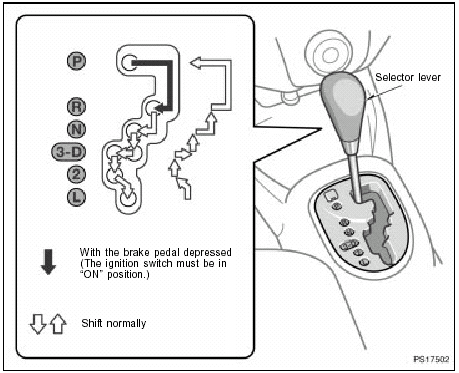 Toyota Yaris: Automatic transmission
Toyota Yaris: Automatic transmission

Your automatic transmission has a shift lock system to minimize the possibility of incorrect operation. This means you can only shift out of “P” position when the brake pedal is depressed (with the ignition switch in “ON” position).
(a) Selector lever
P: Parking, engine starting and key removal.
R: Reverse.
N: Neutral.
D: Normal driving (shifting into overdrive possible).
3: Engine braking (shifting into overdrive not possible).
2: Stronger engine braking.
L: Maximum engine braking
(b) Normal driving
1. Start the engine as instructed in “How to start the engine” in Section 3. The transmission must be in “P” or “N”.
2. With your foot holding down the brake pedal, shift the selector lever to “D”.
When the lever is in the “D” position, the automatic transmission system will select the most suitable gear for running conditions such as normal cruising, hill climbing, hard towing, etc.
Always use the “D” position for better fuel economy and quieter driving. If the engine coolant temperature is low, the transmission will not shift into overdrive gear even in the “D” position.
CAUTION.
Never put your foot on the accelerator pedal while shifting.
3. Release the parking brake and brake pedal. Depress the accelerator pedal slowly for smooth starting.
(c) Using engine braking
To use engine braking, you can downshift the transmission as follows: Shift into the “3” position. The transmission will downshift to third gear and engine braking will be enabled.
Shift into the “2” position. The transmission will downshift to second gear when the vehicle speed drops down to or lower than 86 km/h (53 mph), and stronger engine braking will be enabled.
Shift into the “L” position. The transmission will downshift to first gear when the vehicle speed drops down to or lower than 43 km/h (26 mph), and maximum engine braking will be enabled.
CAUTION.
Be careful when downshifting on a slippery surface. Abrupt shifting could cause the vehicle to skid or spin.
(d) Using “2” and “L” positions
The “2” and “L” positions are used for strong engine braking as described previously.
With the selector lever in “2” or “L”, you can start the vehicle in motion as with the lever in “D”.
With the selector lever in “2”, the vehicle will start in first gear and automatically shift to second gear.
With the selector lever in “L”, the transmission is engaged in first gear.
NOTICE.
Be careful not to over-rev the engine.
Watch the tachometer to keep engine rpm from going into the red zone. The approximate maximum allowable speed for each position is given below for your reference: “2” . . . . . . . . . . . . 103 km/h (64 mph).
“L” . . . . . . . . . . . . . 56 km/h (34 mph).
Do not continue hill climbing or hard towing for a long time in the “2” or “L” position. This may cause severe automatic transmission damage from overheating. To prevent such damage, “D” or “3” position should be used in hill climbing or hard towing.
(e) Backing up
1. Bring the vehicle to a complete stop.
2. With the brake pedal held down with your foot, shift the selector lever to the “R” position.
NOTICE.
Never shift into reverse while the vehicle is moving.
(f) Parking
1. Bring the vehicle to a complete stop.
2. Pull the parking brake lever up fully to securely apply the parking brake.
3. With the brake pedal pressed down, shift the selector lever to the “P” position.
CAUTION.
Never attempt to move the selector lever into “P” position under any circumstances while the vehicle is moving.
Serious mechanical damage and loss of vehicle control may result.
(g) Good driving practice
If the transmission repeatedly shifts up and down between third gear and overdrive gears when climbing a gentle slope, shift the selector lever to the “3” position. Be sure to shift the selector lever to the “D” position immediately afterward.
When towing a trailer, in order to maintain engine braking efficiency, do not use “D” position. The selector lever must be in the “3” position.
CAUTION.
Always keep your foot on the brake pedal while stopped with the engine running. This prevents the vehicle from creeping.
NOTICE.
Always use the brake pedal or the parking brake to hold the vehicle on an upgrade. Do not attempt to hold the vehicle using the accelerator pedal, as this can cause the transmission to overheat.
(h) If you cannot move the selector lever out of “P” position
If you cannot shift the selector lever from the “P” position even though the brake pedal is depressed, use the shift lock override button. For instructions, see “If you cannot shift automatic transmission selector lever”.
 Ignition switch
Ignition switch
“START”—Starter motor on. The key will return to the “ON” position when released.
For starting tips, see Section 3.
“ON”—Engine on and all accessories on.
This is the normal d ...
 Manual transmission
Manual transmission
The shift pattern is conventional as shown above.
Press the clutch pedal down fully while shifting, and then release it slowly.
Do not rest your foot on the pedal while driving, because it will ...
See also:
Rear floor sidemember (CUT): Hatchback
REPLACEMENT
With the body lower back panel removed.
REMOVAL
INSTALLATION
Temporarily install the new parts and measure each part of the new parts in accordance
with the body dimension diagra ...
Engine exhaust cautions
CAUTION.
Avoid inhaling the engine exhaust.
It contains carbon monoxide, which is a colorless and odorless gas. It can cause
unconsciousness or even death.
Make sure the exhaust system has no hol ...
Rear floor side panel extension (ASSY): Hatchback
REPLACEMENT
With the quarter panel and body lower back panel removed.
REMOVAL
INSTALLATION
Temporarily install the new parts and measure each part of the new parts in accord ...
